A Japanese foam cleanser is a water-based face wash, but with a twist. It's specifically designed to create an incredibly rich, dense, and cushiony lather before it ever touches your skin. This is a fundamental difference from many Western cleansers that you work into a foam directly on your face.
The entire philosophy behind a Japanese foam cleanser is to use the micro-bubbles themselves as the cleansing agent, which minimizes friction and potential irritation.
What Makes Japanese Foam Cleansers Different
Picture washing your face not with a harsh, stripping soap, but with a protective cloud. That’s really the best way to describe the experience and the core idea behind a Japanese foam cleanser. This approach is rooted in a deep respect for the skin's natural balance, transforming a daily chore into something more like a mindful ritual. It’s no surprise this step is a cornerstone of the J-Beauty routine.
The real magic is all in the lather. The goal isn't just to make some bubbles; it's to build a firm, elastic foam—often described as "mochi-mochi," just like the soft, bouncy Japanese rice cake. This dense foam acts as a buffer between your hands and your face.
The rich, airy lather does the heavy lifting for you. It dives into pores to gently lift away impurities like sweat, dust, and daily grime without any aggressive rubbing or pulling at your delicate skin.
This technique serves one critical purpose: protecting your skin's vital moisture barrier. When you scrub too harshly, you can cause microscopic tears and strip the skin of its natural oils. This often leads to a whole host of problems:
- Increased dryness and that dreaded tight feeling
- Redness and sensitivity
- Your skin overproducing oil to compensate, which can lead to more issues
A Japanese foam cleanser helps you sidestep all of that. Instead of attacking dirt, it gently envelops and lifts it away, leaving your skin feeling clean, refreshed, and unbelievably soft—never tight or squeaky clean. It's the perfect second step in a double-cleansing routine, designed to purify the skin after an oil cleanser has dissolved makeup and sunscreen.
This gentle yet thorough method prepares your skin to soak up all the good stuff from the serums and moisturizers you apply afterward. Understanding this concept is key, and you can see it perfected in beloved products. For a great example, check out our complete guide to the Hada Labo Gokujyun Face Wash, which explores how its formula masters this gentle cleansing method. It's a completely different mindset that prioritizes long-term skin health over a quick, harsh clean.
The Science Behind the Signature Foam
That luxurious, bouncy foam you get from a Japanese cleanser isn’t just for a fun sensory experience—it’s the result of some serious, skin-loving science. The secret to that signature “mochi-mochi” (soft and bouncy) texture comes from a deep respect for the skin's natural state, starting with a laser focus on pH balance.
You see, healthy skin has a slightly acidic pH of around 5.5, which is crucial for keeping its protective barrier happy and functional. A lot of traditional cleansers are highly alkaline, which throws this delicate balance completely out of whack. This strips your skin of its natural oils, leaving it feeling tight, dry, and totally vulnerable. Japanese foam cleansers, on the other hand, are almost always formulated to be pH-balanced, so they clean your skin thoroughly without messing up its defenses.
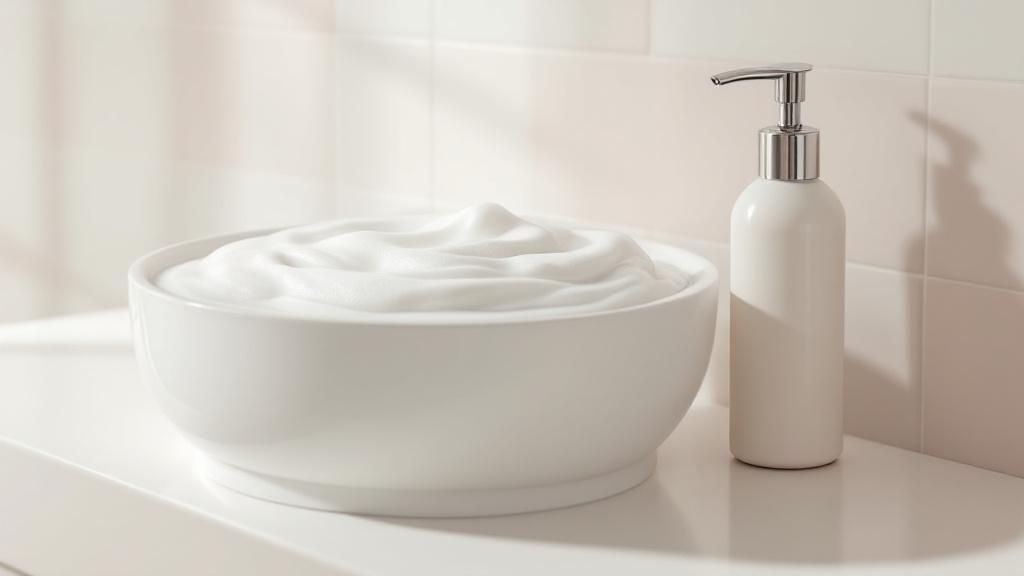
Gentle Surfactants Make All the Difference
The other piece of the puzzle is the choice of cleansing agents, or what we call surfactants. Instead of using harsh sulfates like Sodium Lauryl Sulfate (SLS), which can be incredibly stripping, Japanese formulators lean on gentle, amino acid-based surfactants. These sophisticated ingredients are derived from the very building blocks of protein in our own skin.
This smart choice gives you two massive benefits:
- They Clean Brilliantly: They whip up into a rich, dense foam that’s a pro at lifting away dirt, oil, and impurities from your pores.
- They're Incredibly Gentle: Because they're so similar to what our skin is made of, they cleanse without stripping away that essential moisture.
It’s an approach that creates a product that cleans and conditions at the same time. This focus on gentle-yet-effective formulas has really taken off, with the Asia-Pacific foam cleanser market projected to lead globally. More and more people are catching on to the benefits of amino acid cleansers, and for good reason.
This dedication to gentle science means the cleanser truly respects your skin. It leaves your face feeling soft and hydrated, not squeaky clean and irritated. It’s the perfect prep step for the rest of your skincare routine.
Ultimately, a Japanese foam cleanser is a perfect marriage of a beautiful user experience and smart skin science. To see these principles in action, you should check out our guide to the top 7 best face washes in Japan and find a product that truly embodies this gentle philosophy.
Key Ingredients That Define J-Beauty Cleansing
The gentle, cloud-like foam of a Japanese cleanser is incredible, but its real power comes from what’s inside. These cleansers aren’t packed with harsh, stripping chemicals. Instead, they rely on a thoughtful blend of ingredients—some rooted in ancient tradition, others backed by modern science—to cleanse, soothe, and hydrate all at once.
One of the true heroes you’ll find in many formulas is Hyaluronic Acid. Think of it as a tiny moisture magnet for your skin cells; a single molecule can hold up to 1,000 times its weight in water. When it's part of a cleanser, it ensures your skin holds onto precious moisture during the washing process. This is what prevents that tight, squeaky feeling, leaving your skin feeling plump and happy instead.
If you want to go deeper, exploring the benefits of Japanese Hyaluronic Acid in skincare will show you exactly why it's a staple for achieving that dewy, hydrated look.
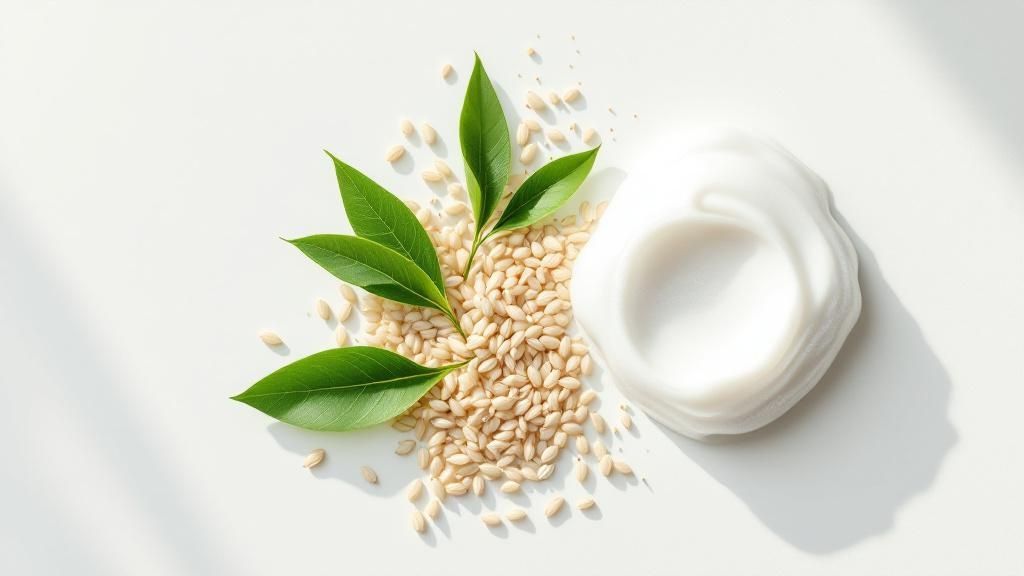
Traditional Powerhouses in Modern Formulas
Beyond the lab-proven humectants, J-Beauty masterfully weaves in traditional botanicals that have been loved for generations. These time-tested ingredients are celebrated for delivering real results without causing irritation, making them a perfect match for the gentle philosophy of Japanese cleansing.
Let's dive into some of the powerful ingredients you'll often find in Japanese foam cleansers and see how they can work for your skin.
Common Ingredients in Japanese Foam Cleansers
| Ingredient | Primary Benefit | Best For Skin Type |
|---|---|---|
| Rice Bran (Komenuka) | Gently exfoliates, brightens, and softens skin texture. It's packed with over 100 vitamins and minerals. | All skin types, especially dull or uneven. |
| Green Tea Extract (Matcha) | A powerful antioxidant that protects from environmental damage and calms inflammation. | Sensitive, acne-prone, or irritated skin. |
| Mugwort (Yomogi) | Soothes redness and irritation with its antibacterial and anti-inflammatory properties. | Sensitive and blemish-prone skin. |
| Job's Tears (Hatomugi) | Brightens and hydrates, helping to improve skin clarity and texture. | Normal, combination, and dull skin. |
| Sake (Fermented Rice) | Rich in amino acids and enzymes that gently exfoliate, hydrate, and brighten the complexion. | Dry, mature, and dull skin. |
By including ingredients that actively nourish and protect, these cleansers elevate a simple daily step into a genuinely therapeutic ritual for your skin.
These cleansers do more than just remove dirt. They actively improve your skin's health with every wash, turning a simple step into a therapeutic treatment.
Getting familiar with what’s in your products is the key to building a routine that works. Learning more about beneficial natural ingredients for healthy skin can help you make smarter choices across the board. The moment you start reading the label, you empower yourself to pick formulas that perfectly suit your skin’s unique needs.
How to Choose the Right Cleanser for Your Skin

Choosing the right Japanese foam cleanser might seem overwhelming at first, but it gets much easier once you learn to speak a little "J-Beauty." The secret is matching the product's promise directly to what your skin is asking for. Thankfully, Japanese brands make this simple by using descriptive terms on their packaging that act like a roadmap to your perfect match.
Think of it like picking out a drink. On a blazing hot day, you crave something light and refreshing. But on a chilly evening, you want a warm, comforting beverage. Japanese cleansers use a similar logic, with specific words signaling their intended effect.
Here are the two most common terms you'll see:
-
Shittori (しっとり): This means "moist" or "dewy." If a label says shittori, it’s a clear sign the cleanser is made for dry or mature skin. These formulas are packed with hydrating heroes like Hyaluronic Acid or Glycerin, leaving your skin feeling soft and plump, never stripped.
-
Sappari (さっぱり): This translates to "refreshing" or "light." A sappari cleanser is your best friend if you have oily or combination skin. These products give you a deep, satisfying clean that cuts through excess oil without over-drying, leaving behind a crisp, comfortable feeling.
Match the Cleanser to Your Skin Type
Beyond these helpful keywords, the most crucial step is aligning your choice with your main skin concern. If you're dealing with acne, you'll want to look for cleansers with calming ingredients like Green Tea Extract or Mugwort to soothe that frustrating inflammation. For those with sensitive skin, always prioritize fragrance-free formulas with gentle, amino acid-based surfactants.
The global demand for effective facial cleansers is huge—the market is projected to hit an incredible USD 25.3 billion by 2032, and Japan is a key player. Why? Because Japanese brands are masters at creating diverse products for very specific needs, especially for sensitive skin, which is a widespread concern. You can explore more data about the facial cleanser market to see just how successful this targeted approach is.
By connecting the ingredients we've already talked about with these descriptive labels, you can walk into any store (or browse online) and confidently pick a Japanese foam cleanser that will give you the results you want, every single time.
Mastering the Perfect Japanese Lather Technique
If you want to get the most out of your Japanese foam cleanser, you need to master the art of the lather. It might sound like a small detail, but it’s the secret to unlocking the cleanser’s full potential. The single most important rule? Create a rich, dense lather in your hands before it ever touches your face.
This isn't just about feeling pampered; it's a critical step that actively protects your skin.
Think about it. When you apply the cleanser directly to your face and start rubbing to make it foam, you're creating unnecessary friction. That tugging can stress your skin. By building a cloud-like lather first, you’re letting millions of tiny micro-bubbles do the hard work for you. These bubbles form a cushion, gently lifting dirt and oil from your pores without stripping your skin’s delicate moisture barrier.
This focus on preparation is a beautiful part of Japanese culture, much like learning how to whisk matcha for a perfect, frothy cup. The right technique makes all the difference.
Creating the Lather by Hand
- Start with clean, damp hands. Squeeze just a small, pea-sized amount of cleanser into your palm. A little goes a long way!
- Add a few drops of lukewarm water to get things started.
- Cup one hand and use the fingertips of your other hand to whip the mixture in quick, circular motions. Keep adding a tiny bit of water as you go until you’ve built a firm, springy, marshmallow-like foam.
Remember: The goal is a dense foam that holds its shape. If you can turn your hand upside down without the lather falling off, you've nailed it!
For an even more luxurious experience, many J-Beauty lovers swear by a foaming net. These simple mesh pouches are brilliant—they whip up an incredibly rich foam with even less product and effort, making your cleanser last much longer.
Perfecting this step is a cornerstone of the Japanese beauty philosophy. It ensures your skin is perfectly clean and ready for the next steps in your routine. To see how this fits into the bigger picture, you can master the Japanese skincare routine steps for glowing skin in our complete guide.
Our Top Japanese Foam Cleanser Picks
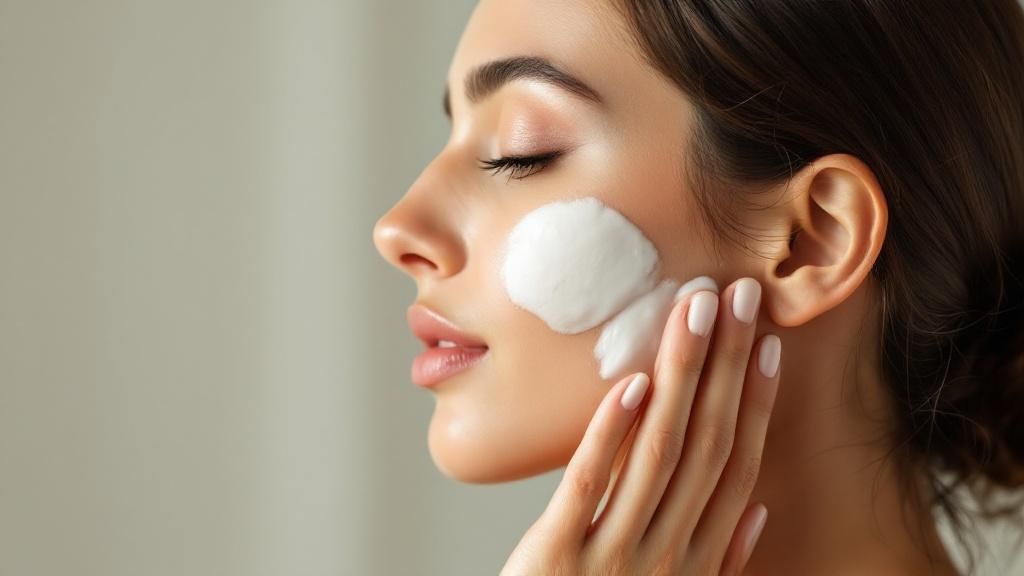 Alright, now that you’ve got the essentials down on what makes Japanese foam cleansers so special, let's look at some real-world examples. Navigating the world of J-Beauty is an adventure, and it’s always easier when you have a few iconic products to start with.
Alright, now that you’ve got the essentials down on what makes Japanese foam cleansers so special, let's look at some real-world examples. Navigating the world of J-Beauty is an adventure, and it’s always easier when you have a few iconic products to start with.
We've handpicked a few cleansers that perfectly embody the concepts we’ve been talking about. Think of this as your curated starting line, featuring everything from a legendary drugstore staple to targeted formulas for mature or sensitive skin. These are the cleansers that have rightfully earned their spot on shelves across the globe.
A Drugstore Classic For Ultimate Hydration
Hada Labo Gokujyun Hyaluronic Acid Face Wash: This is, without a doubt, one of the most loved and widely available Japanese foam cleansers out there. Its genius is in its pure simplicity and incredible performance. The formula is loaded with Super Hyaluronic Acid, which is why it leaves your skin feeling plump and deeply hydrated, never tight or stripped.
Better yet, it's free of fragrance, colorants, and mineral oil. This makes it a go-to choice for almost every skin type, but it’s an absolute game-changer if your skin is on the dry or dehydrated side.
A Premium Pick For Mature Skin
Shiseido Senka Perfect Whip Collagen In: If you're hoping for a cleanser that goes beyond just cleaning, this is a fantastic pick. It whips up into that dense, marshmallow-like foam that Senka is famous for, but this version comes with a powerful anti-aging kick.
This formula features an impressive 60% beauty serum and soluble collagen, working to boost your skin’s firmness and elasticity. It’s a perfect illustration of how Japanese cleansers can weave sophisticated skincare benefits right into the first step of your routine.
Don't forget, the foam wash is the second, critical step in a proper double cleanse. After you've melted away makeup and sunscreen with an oil cleanser, the foam wash gets in there to purify your pores. If you need some recommendations, check out our top Japanese cleansing oil picks for flawless skin.
A Gentle Hero For Sensitive Skin
Curel Intensive Moisture Care Foaming Wash: For anyone whose skin is sensitive or easily angered, Curel is a brand you can truly rely on. This cleanser dispenses as a soft, ready-to-go foam, so you don't even need to lather it up. It’s been specifically created to protect your skin's ceramides—the crucial lipids that keep your moisture barrier strong and healthy.
Being pH-balanced and fragrance-free, this formula cleanses effectively while soothing the skin, making it a safe haven for reactive types. The demand for gentle yet effective products like this is growing worldwide, with the foam facial cleanser market poised for a 7% CAGR through 2033. This trend is largely driven by consumers embracing multi-step routines and seeking out solutions that truly care for their skin. You can read more research on the foam facial cleanser market's growth and see what's influencing it.
A Few Common Questions, Answered
Jumping into the world of J-Beauty is exciting, but it’s natural to have a few questions. Getting straight answers is the best way to feel confident in your routine and get the most out of your new Japanese foam cleanser. Let's clear up some of the most common ones.
Can I Use a Japanese Foam Cleanser Every Day?
Absolutely! In fact, that's exactly what they're designed for.
These cleansers are typically pH-balanced and use incredibly gentle cleansing agents, making them perfect for both your morning and evening skincare rituals. Unlike harsher, stripping cleansers you might have tried before, they clean your skin thoroughly without disturbing its natural moisture barrier.
Do I Still Need to Double Cleanse?
For the best possible results, yes. Think of a foam cleanser as the essential second act in the classic Japanese skincare routine.
First, you'll want to use an oil-based cleanser. This is your "melter" step—it dissolves oil-based impurities like makeup, sunscreen, and that stubborn sebum. The foam cleanser follows, washing away any lingering residue and deep-cleaning your pores for a truly fresh finish.
Is a Foaming Net Really Necessary?
While you can get by without one, a foaming net is a game-changer. I highly recommend it.
A net helps you whip up a much richer, denser, and more luxurious lather than you ever could with just your hands. This cloud-like foam creates a gentle cushion between your hands and your face, enhancing the cleansing effect. Plus, it makes your product last so much longer since you only need a tiny pea-sized amount to create a massive lather.
Ready to feel the difference for yourself? You can explore a hand-picked selection of authentic Japanese foam cleansers and other skincare treasures over at Buy Me Japan. It's the perfect place to find your match and start your journey toward happy, healthy skin.
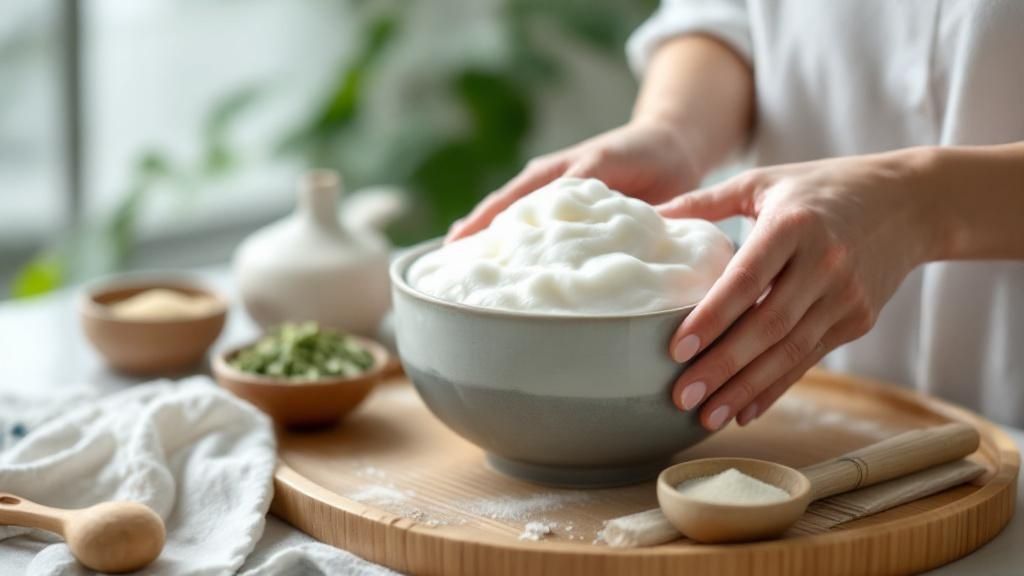
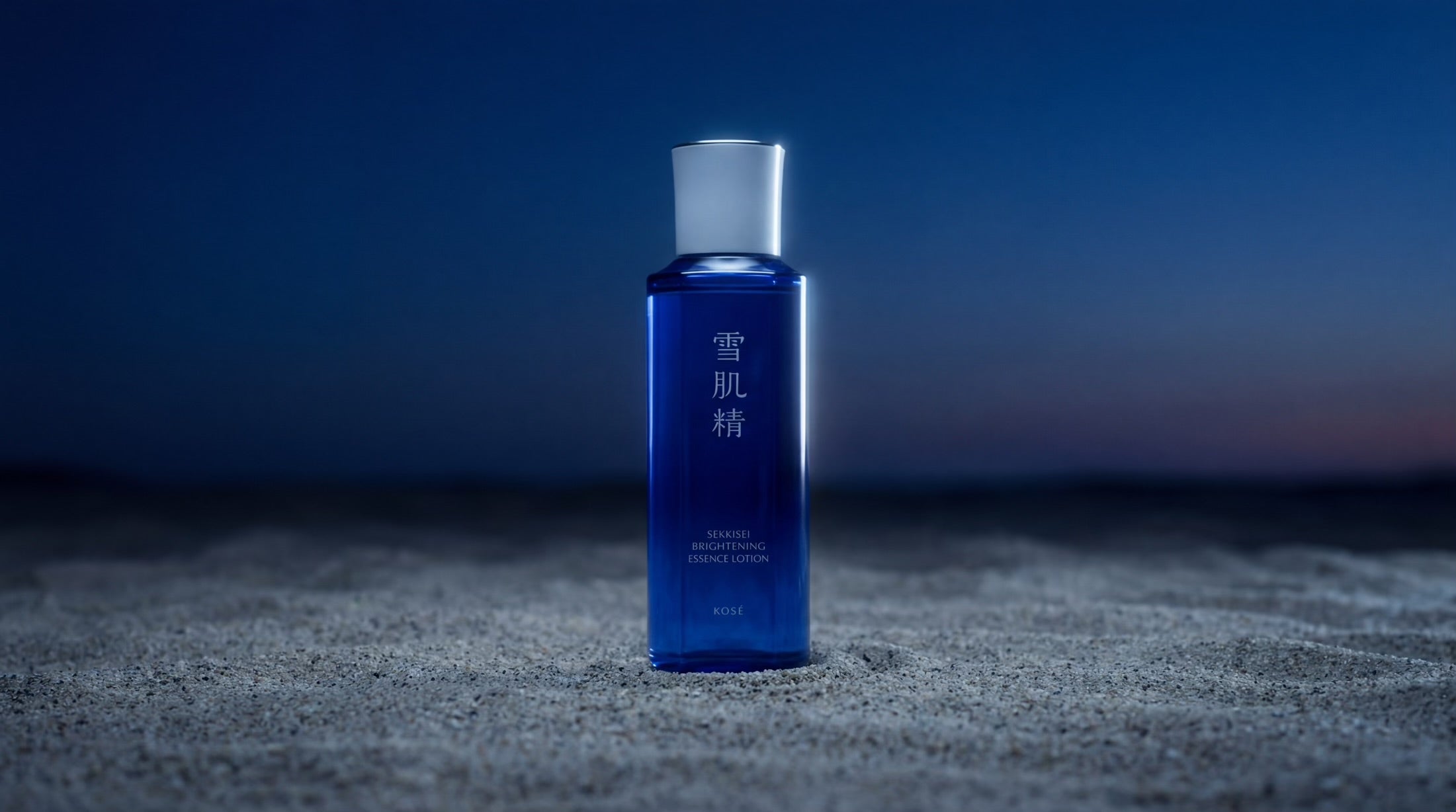
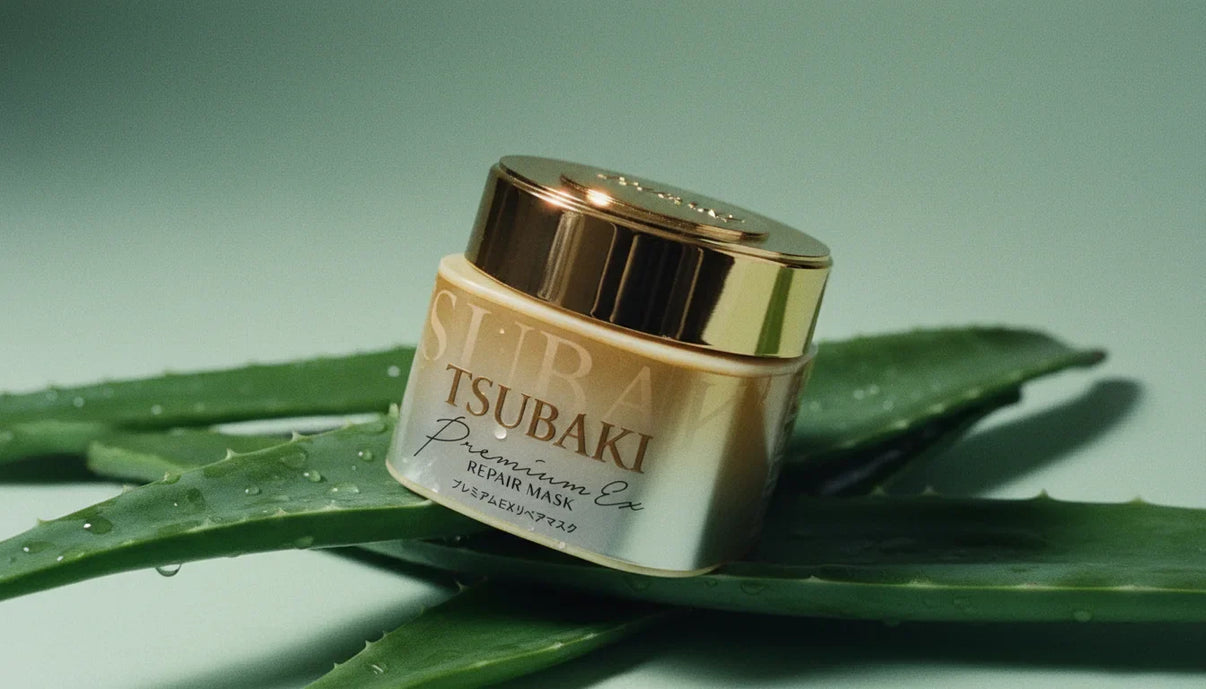
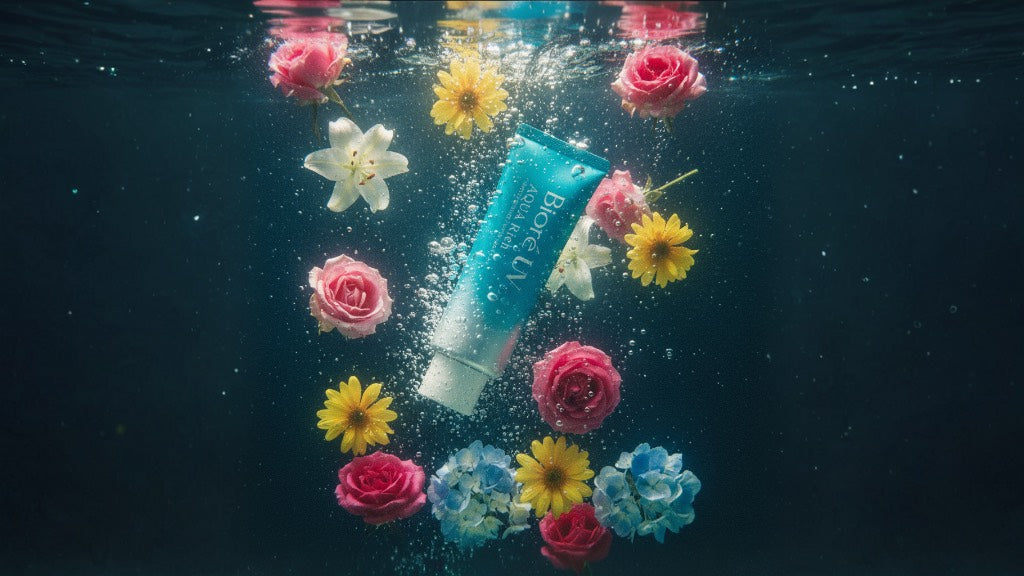
Share:
Your Guide to Japanese Makeup Removers
Master Japanese Eye Makeup Techniques for Stunning Looks